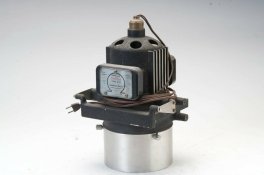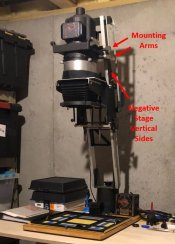Photrio members,
I'm new to the forum and hope someone has a tip/fix for a small issue I have with my Omega DII/D2 enlarger. The issue is not one of negative plane, lens plane, or baseboard plane alignment. Those are dialed in and my print results are sharp across the frame. Here's what I've got:
Setup:
Omega D2 (early, probably 1946 version identical to a DII but labeled D2, with fixed condensers)
Condenser: I use the 4.5-inch diameter condenser that collimates light for 120 format negatives. I don't swap condensers for 135 and 120 formats as I don't need the shorter exposure time a 3-inch condenser would provide.
Issue: If I install a negative carrier in the enlarger without a negative and project a focused rectangle of light on the baseboard, the upper right corner of the frame (as seen by the person viewing the baseboard) appears dimmer than the rest of the frame. The effect on final prints is not visible to my eye even when viewing prints with little to no tonal change in that region of the negative (say, a landscape photo with a clear, nearly uniform tonal sky).
If I gently push the lamp housing to the right I am able to eliminate the dim area, indicating to me that the lamp housing/condenser assembly is slightly off the vertical centerline of the lens/negative. I don't know the long term history of this enlarger but it's in very good shape. When I checked the negative/lens/baseboard alignment prior to using it, it needed no adjustments. I do not observe any bent or damaged bracketry associated with the lamp housing.
Question: Is there an alignment procedure that can assist me in realigning the lamp housing/condenser?
Any help is appreciated,
Thank you,
Dan
I'm new to the forum and hope someone has a tip/fix for a small issue I have with my Omega DII/D2 enlarger. The issue is not one of negative plane, lens plane, or baseboard plane alignment. Those are dialed in and my print results are sharp across the frame. Here's what I've got:
Setup:
Omega D2 (early, probably 1946 version identical to a DII but labeled D2, with fixed condensers)
Condenser: I use the 4.5-inch diameter condenser that collimates light for 120 format negatives. I don't swap condensers for 135 and 120 formats as I don't need the shorter exposure time a 3-inch condenser would provide.
Issue: If I install a negative carrier in the enlarger without a negative and project a focused rectangle of light on the baseboard, the upper right corner of the frame (as seen by the person viewing the baseboard) appears dimmer than the rest of the frame. The effect on final prints is not visible to my eye even when viewing prints with little to no tonal change in that region of the negative (say, a landscape photo with a clear, nearly uniform tonal sky).
If I gently push the lamp housing to the right I am able to eliminate the dim area, indicating to me that the lamp housing/condenser assembly is slightly off the vertical centerline of the lens/negative. I don't know the long term history of this enlarger but it's in very good shape. When I checked the negative/lens/baseboard alignment prior to using it, it needed no adjustments. I do not observe any bent or damaged bracketry associated with the lamp housing.
Question: Is there an alignment procedure that can assist me in realigning the lamp housing/condenser?
Any help is appreciated,
Thank you,
Dan


 . you should be OK.. the reason you are able to adjust the bellows in these enlargers/disallign them is so you can do perspective control at the printing stage... you can basically do what one does with a LF camera but with the enlarger... its loads of fun
. you should be OK.. the reason you are able to adjust the bellows in these enlargers/disallign them is so you can do perspective control at the printing stage... you can basically do what one does with a LF camera but with the enlarger... its loads of fun 

